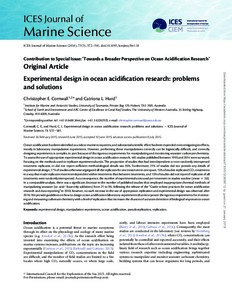| dc.contributor.author | Cornwall, Christopher E. | |
| dc.contributor.author | Hurd, Catriona L. | |
| dc.date.accessioned | 2019-01-21T12:34:55Z | |
| dc.date.available | 2019-01-21T12:34:55Z | |
| dc.date.issued | 2016 | |
| dc.identifier.citation | Cornwall, C. E. and Hurd, C. L.(2016) Experimental design in ocean acidification research: problems and solutions. ICES Journal of
Marine Science, 73, pp.572–581. DOI: 10.1093/icesjms/fsv118 | en_US |
| dc.identifier.uri | http://hdl.handle.net/11329/766 | |
| dc.identifier.uri | http://dx.doi.org/10.25607/OBP-323 | |
| dc.description.abstract | Ocean acidification has been identified as a risk to marine ecosystems, and substantial scientific effort has been expended on investigating its effects, mostly in laboratory manipulation experiments. However, performing these manipulations correctly can be logistically difficult, and correctly designing experiments is complex, in part because of the rigorous requirements for manipulating and monitoring seawater carbonate chemistry.
To assess the use of appropriate experimental design in ocean acidification research, 465 studies published between 1993 and 2014 were surveyed, focusing on the methods used to replicate experimental units. The proportion of studies that had interdependent or non-randomly interspersed treatment replicates, or did not report sufficient methodological details was 95%. Furthermore, 21% of studies did not provide any details of experimental design, 17% of studies otherwise segregated all the replicates for one treatment in one space, 15% of studies replicated CO2 treatments in away that made replicates more interdependent within treatments than between treatments, and 13% of studies did not report if replicates of all
treatments were randomly interspersed. As a consequence, the number of experimental units used per treatment in studies was low (mean ¼ 2.0).
In a comparable analysis, there was a significant decrease in the number of published studies that employed inappropriate chemical methods of manipulating seawater (i.e. acid– base only additions) from 21 to 3%, following the release of the “Guide to best practices for ocean acidification research and data reporting” in 2010; however, no such increase in the use of appropriate replication and experimental design was observed after 2010. We provide guidelines on how to design ocean acidification laboratory experiments that incorporate the rigorous requirements for monitoring and measuring carbonate chemistry with a level of replication that increases the chances of accurate detection of biological responses to ocean acidification. | en_US |
| dc.language.iso | en | en_US |
| dc.subject.other | Pseudoreplication | en_US |
| dc.subject.other | Manipulation experiments | en_US |
| dc.subject.other | Ocean acidification | en_US |
| dc.title | Experimental design in ocean acidification research: problems and solutions. | en_US |
| dc.type | Journal Contribution | en_US |
| dc.description.refereed | Refereed | en_US |
| dc.format.pagerange | pp.572-581 | en_US |
| dc.identifier.doi | 10.1093/icesjms/fsv118 | |
| dc.subject.parameterDiscipline | Parameter Discipline::Chemical oceanography | en_US |
| dc.bibliographicCitation.title | ICES Journal of Marine Science | en_US |
| dc.bibliographicCitation.volume | 73 | en_US |
| dc.bibliographicCitation.issue | 3 | en_US |
| dc.description.sdg | 14.3 | en_US |
| dc.description.eov | Inorganic carbon | en_US |
| dc.description.bptype | Best Practice | en_US |
| dc.description.bptype | Guide | en_US |
| obps.contact.contactemail | christopher.cornwall@uwa.edu.au | |
| obps.resourceurl.publisher | https://academic.oup.com/icesjms/article/73/3/572/2458712?searchresult=1 | en_US |
 Repository of community practices in Ocean Research, Applications and Data/Information Management
Repository of community practices in Ocean Research, Applications and Data/Information Management
